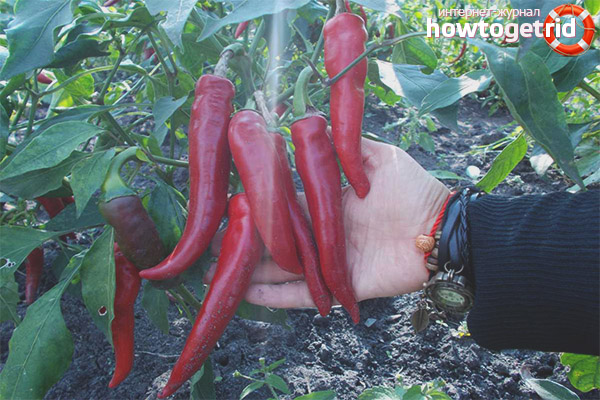The content of the article
Gardeners in our country grow many varieties of bell pepper. Some of them have a sweet taste, others - on the contrary, with a burning sharpness. The mutton horn belongs to this kind. Large fruits are similar to the horns of rams, which is why they got their name. Hot pepper is quite whimsical to the cultivation conditions, so the yield of the variety depends on compliance with the rules of care. Designed for cultivation in greenhouses and greenhouses of various types, as well as in open beds in the garden.
Grade characteristics
Fruiting in the variety begins quite late, 130-150 days after planting. A whimsical vegetable crop needs constant transplants and top dressing. In addition, pepper must be protected from garden pests. Hot pepper is especially appreciated in the countries of Asia, where it is simply necessary to give a spicy spicy taste to local and national dishes. With pepper, they cook such a popular seasoning as adjika. Also added to alcohol to obtain pepper tincture.
Bushes with spreading branches and lush elongated leaves. Landing requires a lot of space. Plants grow to a height of 50 cm. The fruits are long, grow to 50 cm. In diameter, only 1.5 cm. As they ripen, the pepper curls and takes on the shape of a horn. The average weight of one pepper is 30 grams. In the stage of technical ripeness, pepper has a green color, then, as it ripens, it turns into a yellow hue, and when fully ripened, it acquires red. For culinary purposes, it is better to use yellow fruits, when the pepper is fully ripe, the skin becomes stiff. From one bush you can collect 2-2.5 kg of peppers.
For the winter, peppers are pickled and salted, used as a component of winter hot salads and snacks, dried and frozen. The allocated juice from hot pepper irritates the skin very much, does not wash off for a long time, so gloves must be worn when processing vegetables.
Cultivation Features
For full development, crops need to provide good lighting. Daylight hours should be at least 15 hours. To do this, use the lamp. The optimum air temperature should be 25 degrees, but even when the temperature drops to + 15- + 18 degrees, pepper grows well and bears fruit, becoming only more hardy. Drying and waterlogging of the soil should not be allowed. Land should be irrigated with a small amount of water with regularity.
Peppers are planted in a permanent place when the height of the seedlings is about 20 cm. Fertilizers must be applied to the soil and mulched after planting. Between adjacent bushes and between rows should be 50 cm of free space. You can start picking fruits at the end of July. With the beginning of autumn, bushes are moved to greenhouse conditions so that the roots do not die from low temperature. When using a greenhouse to cultivate pepper, plants can grow up to 70-80 cm. In the middle zone of our country, lamb horn pepper can be harvested until November.
Care Rules

For the full growth and development of plants it is necessary to organize favorable conditions.To carry out regular moderate watering with warm water. The procedure should be performed in the evening or in the morning. Waterlogging of the soil must not be allowed, otherwise the root system of plants will begin to rot.
It is also not recommended when watering to get on the leaves of the bushes. Vegetable culture does not respond well to this factor. Water the bushes about 1 time per week. Sharp jumps in the temperature regime have a bad effect on the normal growth and development of the variety. If possible, plants should be protected from the weather. In especially cold weather, the bushes can be covered with covering material.
Diseases
To date, there are several common diseases that pepper is susceptible to.
- Phytoplasmosis. The leaves of the plants turn yellow, and growth stops. In order to protect the bushes from this scourge, you should regularly weed and loosen the ground.
- Bronze Yellow circles appear on peppers. The disease is not treatable, so the affected pepper is destroyed, and healthy fruits are treated with drugs.
- Late blight. On the leaves, fruits and shoots of bushes, a gray coating appears. The disease spreads rapidly, affecting more and more healthy plants. To protect the pepper from late blight, it is necessary to observe the planting scheme, and provide the plants with good illumination. For prevention and protection, special preparations are used, which can be purchased in specialized stores.
Harmful insects
In the gardens there are a large number of pests that can cause significant harm to the culture. Spider mite and aphids feed on plant juices. They get rid of unpleasant invaders with the help of insecticides. Wireworm is dangerous for the root system of pepper. Effective folk recipes are most often used to fight.
The variety of pepper Ram's horn is a whimsical vegetable crop. Only an experienced gardener can cope with its cultivation. It is necessary to regularly carry out care, make plant transplants on time and protect from pests. Not every grower will take up the cultivation of this capricious vegetable.
Video: mutton horn pepper










Submit